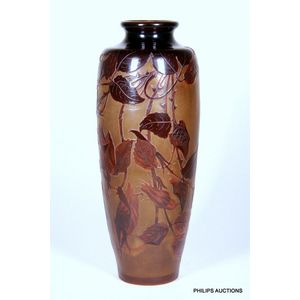Meiji Period Japanese Bronze Vase with Carp and Wisteria
You must be a subscriber, and be logged in to view price and dealer details.
Subscribe Now to view actual auction price for this item
When you subscribe, you have the option of setting the currency in which to display prices to $Au, $US, $NZ or Stg.
- Shakudo - Japanese shakudo is a traditional alloy that has been used in Japan for centuries. It is primarily composed of copper and gold, with the copper serving as the base metal and the gold adding a yellowish hue to the alloy. Shakudo is known for its beautiful dark blue-black or black colour, which is achieved through the addition of a small amount of a patina-inducing element like silver or arsenic.
The word "shakudo" itself can be translated as "red copper" in Japanese, referring to the reddish-brown color of the pure copper base metal before it is patinated. The gold content in shakudo is usually around 4-10%, but this can vary depending on the specific purpose or desired appearance.
Shakudo has been traditionally used in various forms of decorative arts and crafts in Japan. It is particularly associated with metalwork, including sword fittings (such as tsuba, menuki, and kashira), jewelry, and small ornamental objects. The alloy's dark color provides a striking contrast to other metals like silver or gold, making it ideal for intricate inlay work or as a background for other decorative elements. - Bronze - An alloy of copper and tin, traditionally in the proportions of about 9 parts of copper to 1 part of tin.
The discovery of bronze in Western Asia in the 4th century enabled people to create metal objects which were superior to those previoulsy possible because of its strength and hardness, and it has been used throughout the world for weapons, coins, tools, statuary and other decorative items.
It is very fluid in a molten state, and its hardness, strength when set, and non-corrosive properties makes it most suitable for casting sculpture.
This item has been included into following indexes:
-
oriental objects
- bronze vases, Japanese 243
- bronze, other objects 2,529
Visually similar items

Shelley (late Foley) vase. 'Surrey Scenery' small manufacturing fault to base rim. Height 26.5 cm

Japanese bronze vase of tapering form decorated with birds and blossoms

Ceramic floor vase flambe mottled orange, brown, and yellow glaze, impressed crossed horseheads stamp to base, possibly Danish, c. 1960 (A/F),. Height 72 cm, diameter 23 cm

An antique D'Argental cameo vase, circa 1900, a baluster vase with a waisted neck, overlaid with trailing rose buds and thorny branches in chocolate, purple and rust colours upon an amber ground, marked D'Argental in cameo, height 29.5 cm
